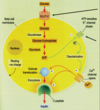Quiz 3 DM Flashcards
(78 cards)
Define Type 2 DM
- Decreased insulin production, and or inability to use normal levels of insulin (insulin resistance) and or increased gluconeogenesis
- Most patients have insulin deficiency
What symptoms are related to poorly controlled blood glucose?
- Glucosuria anf polyuria (high urine [Glucose] and urine output
- Polydipsia (extreme thirst)
- Dehydration
- Weight loss, fluid depletion and lipid breakdown secondary to insulin deficiency in Type 1 DM
- Hyperphagia (increased appetite)
Impaired fasting glucose range?
- 5.6-6.9 mmol/L (100-125 mg/dL)
HHS Hyperglycemi State
Primarily seen in?
Patients with Type 2 DM
Explain the insulin signaling mechanism and its effect on muscle and fat tissue.
Insulin monomer
-
Receptor
-
Cascade
-
This stimulates the tranlocation of intracellular vesicles containing GLUT-4 transport to allow for the uptake of glucose into those tissues.
Without this muscle and fat tissue have no way of taking in glucose
Risks for Hypoglycemia Frequently arise from Exogenous Sources 6 ways
- Excess insulin dose, poorly times relative to glucose load or wrong formulation, poor timing of sulfonylurea dose relative to meals
- Poor attention to maintain blood glucose (Infrequent snacks, especially before overnight fast)
- Excessive exercise without attention to insulin dosage, glucose us exceeds rates of glycogenolysis and gluconeogenesis (distance runners)
- Changes in insulin sensitivity
- Alcohol-induced decrease in endogenous glucose production
- Insulin clearance is reduced, renal disease
Role of Glucocorticoids (GCs) in Affecting Glucose and Lipid metabolism
GCs increase glucose into the circulation to fuel the brains what 4 ways?
- Increase hepatic gluconeogenesis
- Decrease glucose uptake into the muscle and adipose
- Increase the breakdown of fat and muscle to fuel gluconeogenesis
- Inhibit insulin release from B-cells
ADA recommends that all people >__ yrs be evaluated every __ yrs and earlier if what risk factors are present?
- 45, 3
- Family history, Race/ethnicity
- Onesity or BMI >= 25 kg/m^2
- Habitual inactivity
- History of gestational DM or baby birth weight > 9 lbs
- Cardiovascular issues, high triglycerides (>250) and or low HDL Cholesterol (<35 mg/dl)
Mature Onset Diabetes of the Young (MODY)
- All of these are relatively rare and they all show dysfunction in the Beta cell.
If insulin weighs down the teeter totter and doesnt allow glucagon to play what happens?
What if glucagon weighs it down?
- Severe hypoglycemia and death occurs
- Severe diabetic ketoacidosis-death
Explain the incretin effect
Insulin secretion is stimulated much more when glucose is taken orally rather than when taken intravenously so as to result in similar plasma concentrations
DKA diagnostic triad?
- Hyperglycemia (250-600 mg/dl)
- High level of plasma ketone bodies (from fatty acid oxidation)
- Metabolis acidosis (pH 6.8-7.3)
What are insulins effects on gluconeogenesis, glycogenolysis, glycogenesis, Lipogenesis, lipolysis, Protein synthesis, fatty acid oxidation, Triglycerides, proteolysis
- Gluconeogenesis- Inhibition
- Glycogenolysis - Inhibition
- Glycogenesis - Stimulation
- Lipogenesis - Stimulation
- Lipolysis- Inhibition
- Protein synthesis - Increase
- Fatty acid oxidation- Decrease
- Triglycerides- Increase
- Proteolysis- Blocks
Hypoglycemia-Associated Autonomic Failure (HAAF)
2nd defense
Defective glucose counter regulation
- Glucagon response to falling glucose levels is abnormal- becomes progressively worse as duration of DM
- Mechanism of abnormal glucagon secretion from a-cells is not known, linked to insulin deficiency per se since glucagon levels in pancreas may be normal
Go through the insulin signalling mechanism
- Insulin binds to tyrosine kinase which phosphorylates it
- The net result is transloation of Glut-4 transporter where then glucose can be taken up by the cell and utilized, GLUT 4 is present in Muscle and Fat and is dependent on GLUT-4 for glucose usage.
Glucokinase has a very high ___ for glucose and it rapidly falls as?
KM
falls as glucose falls
What are the Incretin GLP-1 modes of action?
Theres 6 but really only 5
- Stimulates glucose dependent insulin secretion
- Suppression of glucagon
- Slows gastric emptying
- Enhances satiaty and reduces food intake
- Improves insulin sensitivity
- Promotes B-cell neogenesis in animal models
Triple Whammy of DKA
3) Metabolic Acidosis
- Ketone bodies are relatively strong acids (pKa 3.5) and are buffered by plasma bicarbonate
- As bicarbonate levels decrease metabolic ketoacidosis ensues
- Ketone bodies excreted in urine and via hyperventilation (Kussmaul breathing) to compensate for metabolic acidosis (Fruity breath)
Life threatening Emergency
The endocrine pancreas is responsible for?
- The production of insulin and glucagon, into pancreatic veins
What are the clinical classfications of impaired fasting glucose?
Normal
Impaired
Diabetic
If you have impaired fasting glucose you arent diabetic
- FPG < 5.6 mM (100 mg/dl) – Normal
- FPG > 5.6 mM but less than 7.0 mM (126 mg/dl) —- IFG
- FPG > 7.0 (126 mg/dl)
Distinction between DKA and HHNKS?

Interrelationship of Glucose Recovery to Major Symptoms of DM.
- Polyuria, glycosuria/glucosuria
- Polydipsia
- Dehydration
- Weight loss
- Hyperphagia (increased appetite)
If you have a mutation in the SGLT2 transporter you can have?
In DM individuals, glucose transport is rate limiting and recovery of excess glucose during hyperglycemia is insufficient this produces?
- renal glucosuria
- Glucosuria
What is the criteria for the diagnosis of diabetes?
There are 4 possible options
- A1C >= 6.5%
- FPG>= 126 (7.0 mmol/L) Fasting is defined as no caloric intake for at least 8 hours
- 2 hour plasma glucose >= 200 mg/dl (11.1 mmol/l) during an OGTT. Glucose load should contain 75 g anhydrous glucose dissolved in water
- In patients with classic symptoms of hyperglycemia or hyperglycemic crisis a random plasma glucose >= 200 mg/dl (11.1 mmol/l)



